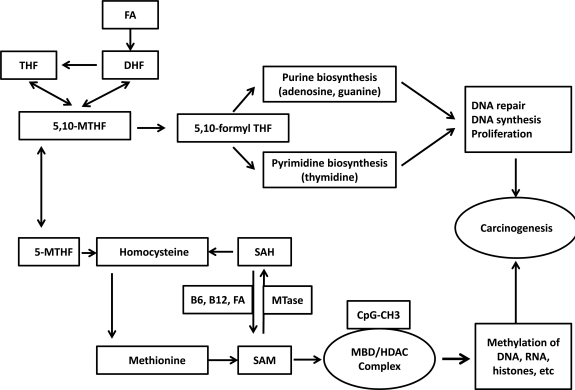Fig. (1).
Schematic representation of dietary factors, one-carbon metabolism, methionine cycle in DNA methylation. One-carbon metabolism is the best understood pathway of dietary regulation of DNA methylation. Folic acid is converted to dihydroflate (DHF) and then to tetrahydrofolate and finally to methylene tetrahydrofolate (MTHF). 5, 10-MTHF is required for the synthesis of nucelic acids, and 5- MTHF is required for the formation of methionine from homocysteine via folate- and B12-dependent methionine synthase reaction. Methionine adenosyl transferase transfers adenosine to methionine and generates S-adenosylmethionine (SAM), which is the main methyl donor. Subsequently, SAM is converted to S-adenosyl homocysteine (SAH), which has high binding affinity to methyltransferases (MTase). A dietary supply of vitamins B12, B6, and folic acid via several steps regenerate SAH to SAM. Methylene tetrahydrofolate (MTHF) can direct folic acid (FA) to nucleotide synthesis as an important path for DNA synthesis, cell growth, and DNA repair or for conversion of homocysteine to methionine. DNA-methyl transferases (MTase) methylates the CpG island which recruits the methyl binding domain (MBD) and histone deacetylases (HDACs) to the methylated DNA and leads to histone deacetylation, condensation of chromatin, loss of transcription factor binding, and silencing of the gene expression in cancer and other premalignant conditions.

